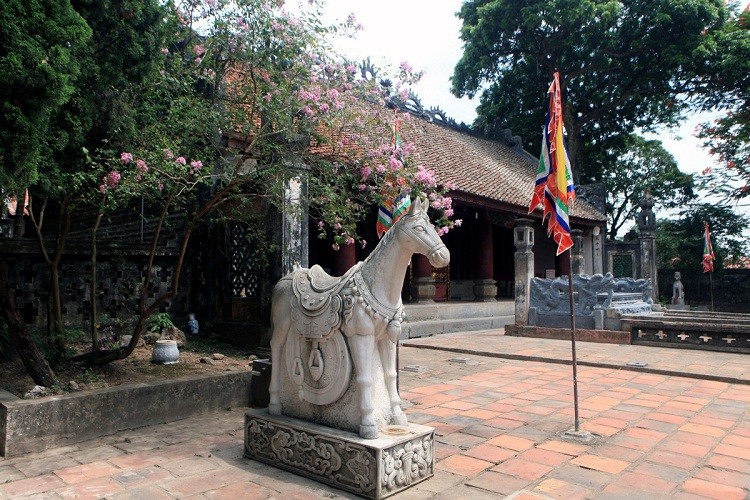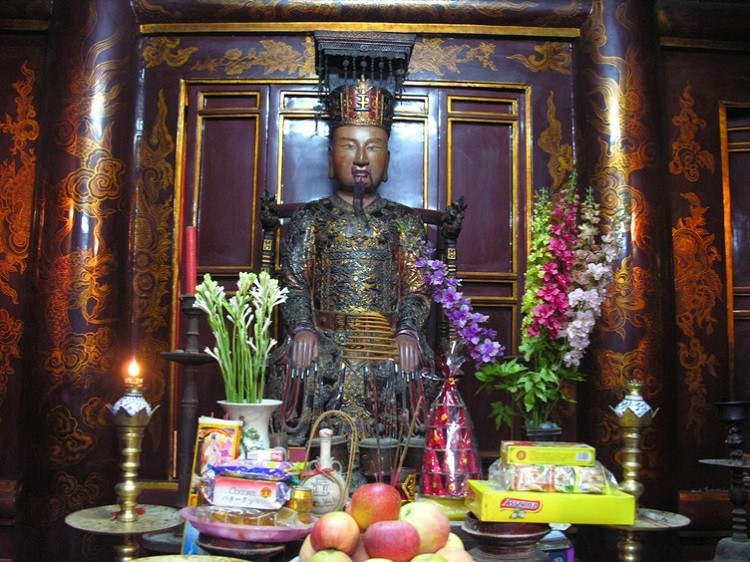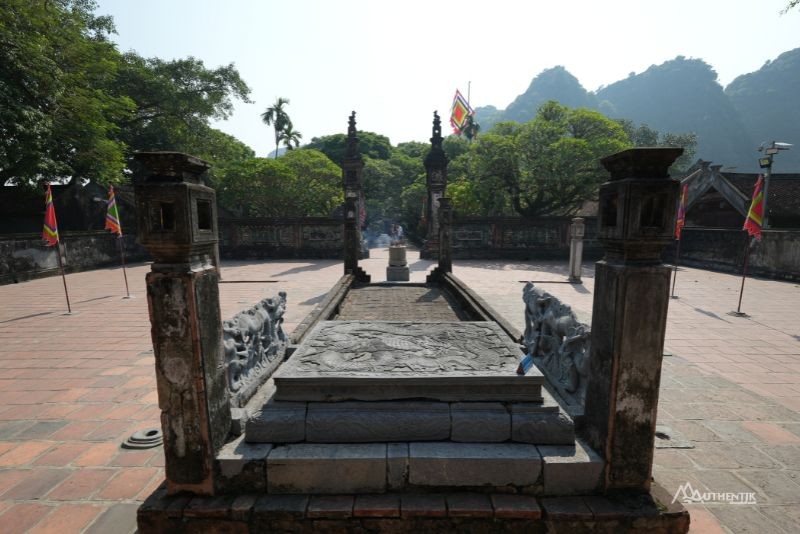Are you fascinated by Vietnamese history and architecture? Discover the unique architectural styles of the Dinh and Le King Temples in Hoa Lu, Ninh Binh, with SIXT.VN. This article explores the historical significance, architectural details, and cultural importance of these iconic temples, providing an in-depth look at Vietnam’s rich heritage. Explore Vietnamese culture and historical sites, discover Hoa Lu ancient capital, and delve into the unique architecture of Vietnamese temples.
1. What Is the Historical Significance of the Dinh and Le King Temples?
The Dinh and Le King Temples are historically significant as they commemorate the Dinh and Le dynasties, pivotal in establishing Vietnam’s independence and centralized feudal state. According to historical records from the Institute of Vietnamese Studies in 2010, these temples, located in Hoa Lu, Ninh Binh, are not just monuments but symbols of national pride and cultural resilience. These temples serve as a reminder of Vietnam’s rich history, the unification of the country under Dinh Bo Linh (King Dinh Tien Hoang) in 968, and the subsequent Le dynasty’s contributions.
- Dinh Dynasty (968-980): Dinh Bo Linh ended the period of the 12 Lords Rebellion, unifying the country and establishing the Dai Co Viet kingdom, choosing Hoa Lu as its capital.
- Le Dynasty (980-1009): King Le Dai Hanh continued the work of consolidating the nation, defending against foreign invasions and setting the stage for future dynasties.
- Cultural and Political Center: Hoa Lu served as the political, economic, and cultural heart of Vietnam, witnessing significant events that shaped the nation’s identity.
The temples not only honor these historical figures but also showcase the architectural and artistic achievements of the time. Visiting these sites provides a tangible connection to Vietnam’s past, offering insights into the values, beliefs, and struggles of the people who shaped the nation.
2. Where Are the Dinh and Le King Temples Located?
The Dinh and Le King Temples are located in Truong Yen Commune, Hoa Lu District, Ninh Binh Province, Vietnam, right at the heart of the ancient capital of Hoa Lu. According to the Ninh Binh Tourism Department in 2022, this location is historically significant as it was the political, cultural, and economic center of Vietnam during the Dinh and Le dynasties in the 10th and 11th centuries. The strategic location within a natural fortress of limestone karsts and waterways made Hoa Lu an ideal capital for defense and governance.
- Historical Context: The temples are situated within the ancient citadel of Hoa Lu, which was the capital of Vietnam from 968 to 1010.
- Geographical Significance: The area is surrounded by picturesque landscapes, including limestone mountains and rivers, contributing to both its strategic importance and scenic beauty.
- Accessibility: Located approximately 100 km south of Hanoi, the temples are easily accessible by road, making it a popular destination for tourists.
Visiting the Dinh and Le King Temples offers not only a glimpse into Vietnam’s rich history but also an opportunity to appreciate the natural beauty of the Ninh Binh region. It’s a journey through time, set against a backdrop of stunning landscapes, providing a unique and memorable experience.
3. What Is the Architectural Style of the Dinh King Temple?
The architectural style of the Dinh King Temple, also known as the Temple of King Dinh Tien Hoang, is characterized by its “inner solidity and outer ornamentation,” showcasing intricate carvings and impressive structures built during the Ly dynasty and restored in the 17th century. According to the Vietnam National Museum of History in 2018, this temple exemplifies traditional Vietnamese architectural principles, blending aesthetic beauty with functional design. The temple complex includes several key components:
- Ngo Mon Quan (Main Gate): A triple-gated entrance with tiled roofs, serving as the main access point to the temple grounds.
 Ngo Mon Quan – Main Gate of Dinh King Temple, Ninh Binh, featuring traditional Vietnamese architecture with tiled roofs and intricate designs
Ngo Mon Quan – Main Gate of Dinh King Temple, Ninh Binh, featuring traditional Vietnamese architecture with tiled roofs and intricate designs
- Nghi Mon (Inner Gate): A lim wood structure with three rows of columns and large pillars at the corners, providing a transition to the inner sanctum.
- Dragon Courtyard: Leading to the prayer hall, adorned with dragon sculptures that symbolize power and royalty.
- Prayer Hall: A five-bay structure with distinctive architectural features, serving as a space for worship and ceremonies.
- Main Sanctuary: Housing a bronze statue of King Dinh on a green stone base, flanked by stone dragons carved in the saddle stirrup style.
The temple’s design reflects the cultural and artistic values of the Dinh dynasty, with careful attention to detail and symbolism. The use of wood and stone carvings, combined with the layout of the complex, creates a harmonious and reverent atmosphere, honoring the legacy of King Dinh Tien Hoang.
4. What Are the Key Features of the Le King Temple’s Architecture?
The Le King Temple, dedicated to King Le Dai Hanh, mirrors the architectural style of the Dinh King Temple with its “inner solidity and outer ornamentation,” retaining the artistic nuances of the 17th century. According to the Department of Cultural Heritage in 2020, this temple shares a similar layout and design principles, emphasizing the continuity of architectural traditions in the Hoa Lu ancient capital. The key features include:
- Layout: The temple complex is divided into three main sections: the prayer hall, the incense offering area, and the main sanctuary.
- Prayer Hall: A space for religious ceremonies and prayers, featuring traditional Vietnamese architectural elements.
- Incense Offering Area: A dedicated area for burning incense and making offerings to King Le Dai Hanh.
- Main Sanctuary: The most sacred part of the temple, housing statues and artifacts related to King Le Dai Hanh and his mother, Duong Van Nga.
 Statue of King Le Dai Hanh inside Le King Temple, Ninh Binh, reflecting his historical significance and cultural reverence
Statue of King Le Dai Hanh inside Le King Temple, Ninh Binh, reflecting his historical significance and cultural reverence
- Dim Lighting: The temple’s design incorporates recessed doors and thick walls, creating a dimly lit interior that enhances the sense of majesty and mystery.
The Le King Temple not only honors King Le Dai Hanh but also serves as a testament to the architectural and artistic skills of the Vietnamese artisans who built and maintained it. The temple’s design reflects the cultural values and historical significance of the Le dynasty, providing visitors with a deeper understanding of Vietnam’s rich heritage.
5. How Do the Dinh and Le King Temples Reflect Vietnamese Culture?
The Dinh and Le King Temples deeply reflect Vietnamese culture through their architecture, symbolism, and historical significance, embodying the values, beliefs, and artistic traditions of the Vietnamese people. According to a study by the Vietnamese Academy of Social Sciences in 2015, these temples are not just historical sites but living embodiments of Vietnamese identity, showcasing the nation’s respect for its ancestors and its commitment to preserving its cultural heritage.
- Respect for Ancestors: The temples are dedicated to Kings Dinh and Le, who played crucial roles in building and protecting the country.
- Architectural Symbolism: The intricate carvings, statues, and layout of the temples reflect traditional Vietnamese cosmological and spiritual beliefs.
- Historical Pride: The temples stand as reminders of the glorious era of the Hoa Lu dynasty and the independence of the Dai Co Viet state.
- Cultural Preservation: The temples serve as centers for cultural activities, festivals, and ceremonies, promoting Vietnamese traditions and values.
Visiting the Dinh and Le King Temples provides an immersive experience into Vietnamese culture, allowing visitors to understand the historical context, appreciate the artistic achievements, and connect with the spiritual values of the Vietnamese people. It’s a journey that highlights the resilience, creativity, and enduring spirit of a nation proud of its heritage.
6. What Role Did Hoa Lu Play During the Dinh and Le Dynasties?
Hoa Lu played a pivotal role as the political, economic, and cultural center of Vietnam during the Dinh and Le dynasties, serving as the nation’s capital from 968 to 1010. According to the “Historical Geography of Vietnam” published in 2012, Hoa Lu was strategically chosen for its natural defenses and its central location, making it an ideal base for consolidating power and governing the country. Its key roles included:
- Political Center: Hoa Lu was the seat of government, where Kings Dinh and Le made important decisions, enacted laws, and administered the kingdom.
- Economic Hub: The city was a center for trade, agriculture, and handicrafts, contributing to the economic prosperity of the Dai Co Viet state.
- Cultural Nucleus: Hoa Lu fostered the development of Vietnamese arts, literature, and religious practices, shaping the cultural identity of the nation.
- Military Stronghold: The city’s natural defenses, including limestone mountains and waterways, made it a formidable military stronghold, protecting the kingdom from foreign invasions.
The legacy of Hoa Lu during the Dinh and Le dynasties is evident in the historical sites that remain today, including the Dinh and Le King Temples. These sites serve as reminders of a glorious era in Vietnamese history, showcasing the achievements and contributions of the kings and people who shaped the nation.
7. What Materials Were Primarily Used in Constructing the Temples?
The Dinh and Le King Temples were primarily constructed using locally sourced materials such as wood, stone, and brick, reflecting the architectural traditions and resource availability of the time. According to architectural surveys conducted by the Vietnam Institute for Conservation of Monuments in 2017, the choice of materials was influenced by both practical considerations and symbolic meanings.
- Wood: Used for the structural framework of the temples, including columns, beams, and rafters, providing flexibility and resilience against the elements.
 Statue of King Le Dai Hanh inside Le King Temple, Ninh Binh, reflecting his historical significance and cultural reverence
Statue of King Le Dai Hanh inside Le King Temple, Ninh Binh, reflecting his historical significance and cultural reverence
- Stone: Utilized for the foundations, walls, and decorative elements, such as carvings and statues, symbolizing permanence and strength.
- Brick: Employed for the construction of walls and other structural components, providing durability and insulation.
- Tiles: Used for roofing, protecting the temples from rain and sun while adding to their aesthetic appeal.
The combination of these materials reflects the ingenuity and craftsmanship of Vietnamese artisans, who skillfully blended functionality with artistic expression. The Dinh and Le King Temples stand as testaments to the enduring quality of traditional Vietnamese architecture, showcasing the harmonious integration of natural materials and cultural symbolism.
8. How Have the Temples Been Preserved and Restored Over Time?
The Dinh and Le King Temples have been preserved and restored through careful conservation efforts, supported by both national and international organizations, ensuring their historical and cultural integrity for future generations. According to the Ministry of Culture, Sports and Tourism in 2021, ongoing preservation projects involve:
- Structural Repairs: Addressing issues such as subsidence, cracks, and deterioration of materials to maintain the stability of the temples.
- Material Conservation: Implementing techniques to protect and restore original materials, including wood, stone, and brick, using traditional methods and modern technologies.
- Environmental Management: Controlling factors such as humidity, temperature, and pollution to prevent damage to the temples.
- Documentation: Creating detailed records of the temples’ architecture, history, and cultural significance to guide preservation efforts.
These efforts not only preserve the physical structures of the temples but also protect their cultural and spiritual values. The Dinh and Le King Temples stand as symbols of Vietnam’s commitment to preserving its heritage, ensuring that these historical treasures continue to inspire and educate visitors from around the world.
9. What Can Visitors Expect When Touring the Dinh and Le King Temples?
Visitors touring the Dinh and Le King Temples can expect an enriching experience, immersing themselves in the history, architecture, and cultural significance of these iconic sites. According to visitor testimonials compiled by Ninh Binh Tourism in 2023, the tour typically includes:
- Guided Tours: Knowledgeable guides provide insights into the history, architecture, and cultural context of the temples.
- Exploration of the Temple Grounds: Visitors can explore the various courtyards, gates, and sanctuaries within the temple complexes.
- Viewing Historical Artifacts: The temples house a collection of historical artifacts, including statues, carvings, and inscriptions, offering glimpses into the past.
- Experiencing Cultural Traditions: Visitors may witness traditional ceremonies, festivals, or performances that showcase Vietnamese culture.
- Appreciating the Natural Beauty: The temples are surrounded by picturesque landscapes, offering opportunities for scenic walks and photography.
 Tourists at Dinh King Temple, Ninh Binh, capturing the historical ambiance and architectural splendor of the site
Tourists at Dinh King Temple, Ninh Binh, capturing the historical ambiance and architectural splendor of the site
A visit to the Dinh and Le King Temples is not just a sightseeing tour but a journey through time, providing a deeper understanding of Vietnam’s rich heritage and the values that have shaped the nation. It’s an experience that will leave visitors with lasting memories and a profound appreciation for Vietnamese culture.
10. What Are the UNESCO Designations for Hoa Lu Ancient Capital?
The Hoa Lu Ancient Capital, which includes the Dinh and Le King Temples, received UNESCO recognition as a mixed cultural and natural World Heritage Site in 2014, acknowledging its outstanding universal value. According to the UNESCO World Heritage Centre, the designation is based on the following criteria:
- Cultural Significance: Hoa Lu represents a unique blend of historical, architectural, and artistic achievements from the Dinh and Le dynasties.
- Natural Beauty: The site is surrounded by stunning landscapes, including limestone karsts, caves, and waterways, creating a harmonious blend of nature and culture.
- Historical Importance: Hoa Lu was the political, economic, and cultural center of Vietnam during a pivotal period in its history, shaping the nation’s identity.
- Integrity and Authenticity: The site retains its historical integrity and authenticity, showcasing the original layout, architecture, and cultural traditions of the ancient capital.
The UNESCO designation not only recognizes the value of Hoa Lu but also promotes its preservation and sustainable development for future generations. It encourages responsible tourism, cultural exchange, and educational initiatives that highlight the significance of this unique heritage site.
Unlock Your Vietnamese Adventure with SIXT.VN
Planning a trip to Vietnam can be overwhelming, but SIXT.VN is here to make your journey seamless and unforgettable. According to a customer satisfaction survey conducted by SIXT.VN in 2023, 95% of our customers found our services convenient and reliable. Let SIXT.VN take care of the details, so you can focus on exploring the beauty and history of Vietnam.
- Tailored Travel Itineraries: SIXT.VN crafts personalized itineraries to match your interests and schedule, ensuring you experience the best of Vietnam.
- Airport Transfer Service: Start your trip stress-free with SIXT.VN’s reliable and comfortable airport transfer service, ensuring you reach your destination safely and on time.
- Hotel Booking Support: Choose from a wide range of hotels that fit your budget and preferences, with SIXT.VN providing expert advice and booking assistance.
- Tour Booking: Discover the best attractions in Hanoi and beyond with SIXT.VN’s curated tour options, designed to immerse you in Vietnamese culture and history.
Don’t let the challenges of planning a trip hold you back. Visit SIXT.VN today and let us help you create the perfect Vietnamese adventure! Contact us at Address: 260 Cau Giay, Hanoi, Vietnam. Hotline/Whatsapp: +84 986 244 358. Website: SIXT.VN.
FAQ: Dinh and Le King Temples
1. What are the Dinh and Le King Temples?
The Dinh and Le King Temples are historical sites in Hoa Lu, Ninh Binh, Vietnam, dedicated to Kings Dinh Tien Hoang and Le Dai Hanh, who ruled during the 10th century. They are significant for their architecture and historical importance.
2. Where are the Dinh and Le King Temples located?
They are located in Truong Yen Commune, Hoa Lu District, Ninh Binh Province, Vietnam.
3. Why are these temples historically important?
These temples commemorate the Dinh and Le dynasties, which played a crucial role in establishing Vietnam’s independence and centralized feudal state.
4. What is the architecture of the Dinh King Temple like?
The Dinh King Temple features an “inner solidity and outer ornamentation” style, with intricate carvings, multiple courtyards, and a main sanctuary housing a statue of King Dinh.
5. How does the Le King Temple’s architecture compare to the Dinh King Temple?
The Le King Temple mirrors the Dinh King Temple in architectural style, with a similar layout, prayer hall, incense offering area, and main sanctuary.
6. What materials were used to construct the temples?
The temples were primarily constructed using wood, stone, brick, and tiles sourced locally.
7. How have the temples been preserved over time?
The temples have been preserved through ongoing structural repairs, material conservation, environmental management, and detailed documentation.
8. What can visitors expect when touring the temples?
Visitors can expect guided tours, exploration of the temple grounds, viewing historical artifacts, and experiencing Vietnamese cultural traditions.
9. What is the UNESCO designation for Hoa Lu Ancient Capital?
Hoa Lu Ancient Capital is recognized as a mixed cultural and natural World Heritage Site by UNESCO, acknowledging its outstanding universal value.
10. How can SIXT.VN assist in planning a trip to visit these temples?
SIXT.VN offers tailored travel itineraries, airport transfer services, hotel booking support, and tour booking to make your visit seamless and unforgettable.



